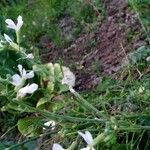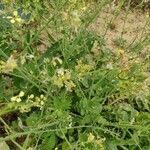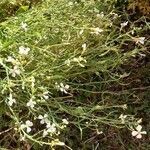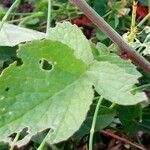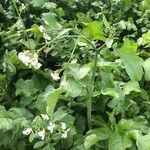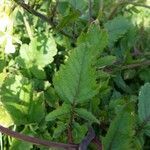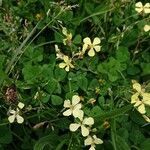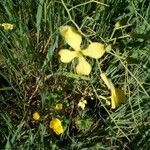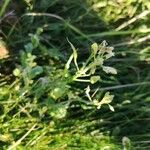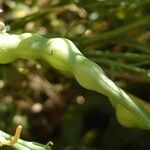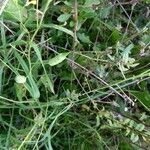Herbs annual, (20-)25-60(-75) cm tall, often hispid. Roots not fleshy. Stems erect or prostrate, usually retrorsely hispid. Basal leaves with petioles 1-6 cm; leaf blade oblong, obovate, or oblanceolate in outline, 3-15(-22) × 1-5 cm, lyrate or pinnatifid, sometimes undivided, margin dentate, apex obtuse or acute; lateral lobes 1-4 on each side of midvein, oblong or ovate, to 4 × 2 cm, smaller than terminal lobe. Uppermost cauline leaves subsessile, often undivided, dentate. Fruiting pedicels divaricate or ascending, straight, 0.7-2.5 cm. Sepals narrowly oblong, 7-11 × 1-2 mm, sparsely pubescent. Petals yellow or creamy white, with dark brown or purple veins, broadly obovate, 1.5-2.5 cm × 4-7 mm, apex obtuse or emarginate; claw to 1.5 cm. Filaments slender, 7-12 mm; anthers 2-2.5 mm, sagittate at base. Fruit cylindric or narrowly lanceolate; valvular segment seedless, 1-1.5 mm; seed-bearing distal segment (1.5-)2-11(-14) cm × (2.5-)3-8(-11) mm, woody or corky, rounded at base, conical at apex, strongly constricted between seeds, strongly ribbed; style 1-5 cm; stigma entire. Seeds oblong or ovoid, 2.5-3.5 × 1.8-2.5 mm. Fl. May-Sep, fr. Jun-Oct. 2n = 18.
Annuals, roots not fleshy; sparsely to densely pubescent. Stems usually simple from base, (2-)3-8 dm, (retrorsely hispid). Basal leaves: petiole 1-6 cm; blade oblong, obovate, or oblanceolate in outline, lyrate or pinnatifid, sometimes undivided, 3-15(-22) cm × 10-50 mm, margins dentate, apex obtuse or acute; lobes 1-4 each side, oblong or ovate, to 4 cm × 20 mm (smaller than terminal). Cauline leaves (distal) subsessile; blade often undivided. Fruiting pedicels divaricate or ascending, 7-25 mm, (straight). Flowers: sepals 7-11 × 1-2 mm, sparsely pubescent; petals yellow or creamy white (veins dark brown or purple), 15-25 × 4-7 mm, claw to 15 mm; filaments (slender), 7-12 mm; anthers 2-2.5 mm. Fruits cylindrical or narrowly lanceolate; valvular segment 1-1.5 mm; terminal segment (1.5-) 2-11(-14) cm × (2.5-)3-8(-11) mm, (base rounded), strongly constricted between seeds (usually breaking), strongly ribbed, beak narrowly conical; style 10-50 mm. Seeds (reddish brown or dark brown to black), oblong or ovoid, 2.5-3.5 × 1.8-2.5 mm. 2n = 18.
Coarse annual from a stout taproot, 3–8 dm, usually sparsely hispid; lower lvs obovate-oblong, 1–2 dm, pinnatifid into 5–15 oblong segments, the lower segments very small, the upper progressively larger; upper lvs reduced and often entire; pet yellow, turning white, 10–15 mm; mature pedicels ascending, 8–15 mm; fr nearly cylindric when fresh, when dry becoming prominently several-ribbed and constricted between the 4–10 seeds, the body 2–4 cm, the beak 1–3 cm, the lower member 1–2 mm, its upper margin indicated by a line or projecting rim extending half way to all around the fr; 2n=18. Native of Eurasia, established as a weed in fields and waste places and along roadsides throughout most of the U.S. and s. Can. June–Aug.
Annual to perennial. Taproot swollen or slender. Stems usually green, (10)-20-80-(100) cm tall. Rosette and lower stem lvs lyrate-pinnate; terminal leaflet 3-6-(10) × 3-6-(10) cm, as wide or narrower than rest of lf; lateral leaflets in 1-8 pairs. Stem lvs simple or with 1 pair of basal lobes, orbicular to lanceolate, 1-6 cm long. Racemes 15-40-(60) cm long. Pedicels 1-2 cm long, stout at fruiting. Sepals 6-9 × 1-2 mm. Petals yellow, white, brownish, pink, or mauve, usually mauve-veined, 13-20 mm long. Silique (1)-2-8-seeded, cylindric, constricted between seeds, breaking into segments when ripe, weakly to strongly ribbed, tapering at apex, (10)-20-60-(80) × (2)-3-8-(9) mm. Seeds 1.5-3 mm long.
Annual or biennial herb, up to 0.1 m high. Stems erect, hispid in lower part, less densely hairy above. Leaves petiolate; basal and lower stem leaves lyrate-pinnatipartite, 2-5-jugate, 100-150 mm long, lobes ovate, margins dentate, appressed-hairy and ciliate, petiole grooved; upper stem leaves ± oblong to narrowly ovate, base cuneate; petiole with margins sharply dentate. Flowers: in terminal racemes, congregated into a panicle; petals obovate, 15-20 mm long, apices rounded or emarginate; white, yellow, shades of purple; Oct.-May. Fruit with siliquae on ascending pedicels of variable length, 20-60 x 3-5 mm, breaking into 1-seeded portions, hard.
Annual or biennial herb, 0.25-1.00 m high. Stems erect, branched, lower part hispid, less hairy above. Leaves: basal leaves petiolate, lyrate-pinnatipartite, 2-5-jugate, lobes ovate, dentate, terminal lobes large, lobulate; lower cauline leaves similar, upper ones petiolate, subglabrous, oblong to lanceolate, cuneate, sharply dentate, incised at base. Inflorescence a terminal raceme. Flowers white, yellow, violet, lilac or purple. Sepals elliptic-lanceolate, glabrous or with a few hairs at apex. Petals obovate, rounded or emarginate, clawed. Flowering time all year. Fruit a siliqua, on ascending pedicels. Seeds subglobose, reticulate.
Annual herb, slender, erect, 15–50 (occasionally up to 150) cm high, simple or branched, scabrous with spreading or reflexed bristles. Lower leaves 15–20 cm long, lyrate-pinnatifid, the terminal lobe large, lateral lobes 1–4, distant, scabrous; upper leaves reducing. Sepals 5–10 mm long, erect. Petals 12–20 mm long, yellow or white, usually dark-veined. Siliqua 2–9 cm long, 3–4 (occasionally to 6) mm wide, erect on ascending pedicels 1–5 cm long; beak slender-conical, 10–30 mm long; valve region constricted between the 3–8 seeds, readily breaking into ribbed, bony, 1-seeded units. Seeds 1.5–4 mm wide, light-brown.
A cabbage family herb. It is an annual herb. It grows 80-100 cm high. It is rough to the touch. The stems branch at the base. The stems are solid but with grooves along them. The stems have downward directed hairs. The lower leaves are larger than the leaves higher up the stem. The lower leaves occur in a ring. The lower leaves are lobed and 20 cm long. The flower is at the top. The flower petals can be white, yellow or lilac and do not overlap. The fruit is a long pointed pod. It is 3-7 cm long and 3-4 mm wide. It is constricted between the seeds. It is held erect.
Annual or biennial herb, 150-800 mm tall, with a stout taproot. Leaves lyrate, pinnatisect with large terminal lobe, 100-150 mm long, becoming smaller upwards. Flowers in a long raceme, white or yellow, mostly violet-veined. Fruit 30-90 x 3-6 mm, hard, longitudinally grooved, constricted between seeds, breaking crosswise into 1-seeded portions.
Annual or biennial herb up to 0.8 m high. Petals 15-20 mm long, long clawed, blade obovate. Fruit 3-5 mm in diameter, breaking into 1-seeded portions, hard. Flowers yellow.
